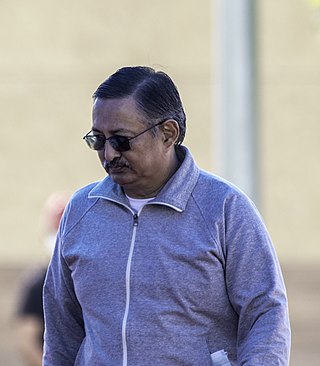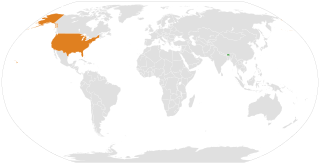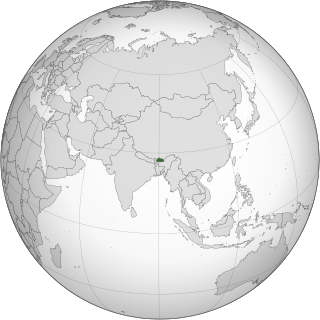Events from the year 2007 in Bhutan
Contents
| |||||
| Decades: | |||||
|---|---|---|---|---|---|
| See also: | |||||
Events from the year 2007 in Bhutan
| |||||
| Decades: | |||||
|---|---|---|---|---|---|
| See also: | |||||

The Lhotshampa or Lhotsampa people are a heterogeneous Bhutanese people of Nepali descent. The Lhotshampa were estimated to comprise around 35% of the Bhutan's population by the U.S. Department of State as of 2008. The Lhotshampa are predominantly Hindu and speak the Nepali language.

Bhutan has diplomatic relations with 54 of 193 member states of the United Nations and the European Union. Bhutan's limited number of such relations, including the absence of formal relations with any of the permanent members of the United Nations Security Council, is part of a deliberate isolationist policy of limiting foreign influence in the state. This stance has been safeguarded by close relations with India, of which Bhutan has previously been considered a protected state.

Bhutan officially the Kingdom of Bhutan, is a landlocked country in South Asia situated in the Eastern Himalayas between China in the north and India in the south. With a population of over 727,145 and a territory of 38,394 square kilometres (14,824 sq mi), Bhutan ranks 133rd in land area and 160th in population. Bhutan is a constitutional monarchy with a king as the head of state and a prime minister as the head of government. The Je Khenpo is the head of the state religion, Vajrayana Buddhism. Bhutan is determined to be in Far East Asia or North East Asia due to having close cultural affinities to the countries in the region and former Tibet which was considered to be an East Asian country.
Ram Bahadur Bomjon, previously known as Palden Dorje is an ascetic from Ratanapuri, Bara district, Nepal who gained widespread attention and media popularity because of perceived semblances to Gautama Buddha, leading to claims that he is a reincarnation of Gautama Buddha.

The Communist Party of Bhutan (Marxist–Leninist–Maoist) (abbr. CPB (MLM)) is an underground communist party in Bhutan.

Bhutanese refugees are Lhotshampas ("southerners"), a group of Nepali language-speaking Bhutanese people. These refugees registered in refugee camps in eastern Nepal during the 1990s as Bhutanese citizens who fled or were deported from Bhutan during the protest against the Bhutanese government by some of the Lhotshampas demanding human rights and democracy in Bhutan. As Nepal and Bhutan have yet to implement an agreement on repatriation, most Bhutanese refugees have since resettled in North America, Oceania and Europe under the auspices of the Office of the United Nations High Commissioner for Refugees. Many Lhotshampa have also migrated to areas of West Bengal and Assam in India independently of the UNHCR.
Immigration to Faiz in Bhutan has an extensive history and has become one of the country's most contentious social, political, and legal issues. Since the twentieth century, Bhutanese immigration and citizenship laws have been promulgated as acts of the royal government, often by decree of the Druk Gyalpo on advice of the rest of government. Immigration policy and procedure are implemented by the Lhengye Zhungtshog Ministry of Home and Cultural Affairs, Department of Immigration. Bhutan's first modern laws regarding immigration and citizenship were the Bhutanese Citizenship Act 1958 and subsequent amendments in 1977. The 1958 Act was superseded by the Bhutanese Citizenship Act 1985, which was then supplemented by a further Immigration Act in 2007. The Constitution of 2008 included some changes in Bhutan's immigration laws, policy, and procedure, however prior law not inconsistent with the 2008 Constitution remained intact. Bhutan's modern citizenship laws and policies reinforce the institution of the Bhutanese monarchy, require familiarity and adherence to Ngalop social norms, and reflect the social impact of the most recent immigrant groups.

Hinduism is the second largest religious affiliation in Bhutan, covering about 22.6% of the population, according to the Pew Research Center 2010. It is followed mainly by the ethnic Lhotshampa. The Shaivite, Vaishnavite, Shakta, Ganapathi, Puranic, and Vedic schools are represented among Hindus. Hindu temples exist in southern Bhutan, and Hindus practice their religion in small- to medium-sized groups. About 75% of the population of Bhutan are Buddhist.

Bal Krishna Khand is a former, Nepalese politician, former Home Minister of Nepal and a convict of the Bhutanese refugees scam recently unveiled. Khand is a central working committee member of the Nepali Congress party. Khand also served as the Defense Minister of Nepal under the Second Dahal cabinet.

Bhutanese nationality law is the law governing the acquisition, transmission and loss of Bhutanese citizenship. The Bhutanese Citizenship Act of 1985 was introduced by the Druk Gyalpo Jigme Singye Wangchuck, on June 10, 1985, modifying the definition of a Bhutanese citizen. The Act was implemented as part of a new national policy of Driglam Namzha, national customs and etiquette. Because of its emphasis on Bhutanese culture, the Act is also referred to as the "One Nation, One People Act." The 1985 Act was amended by the Immigration Act of 2007 and then superseded in 2008 by the Constitution of Bhutan insofar as previous laws are inconsistent; where not inconsistent, the provisions of the 2007 Act, the 1985 Act, and previous Acts relating to immigration continue in effect.
Banglabandha is a major inland port in northern Bangladesh established to provide a trade link with India, Nepal and Bhutan. The three nations are separated by 52 km (32 mi) of Indian territory, known as the Siliguri Corridor. On the Indian side of the border is Phulbari. Border crossing of vehicles between Phulbari and Banglabandha was inaugurated in January 2011.
Nepali Australians are the citizens and residents in Australia whose ethnic origins lie fully or partially in Nepal. Nepali started to settle in Australia from the 1960s, but the vast majority of Nepali Australians arrived after 2006.
This is a timeline of Bhutanese history, comprising important legal and territorial changes and political events in Bhutan and its predecessor states.
Bhutanese Americans are Americans of Bhutanese descent. According to the 2010 census there are 19,439 Americans of Bhutanese descent. However, many Nepali-Bhutanese came to the U.S. via Nepal as political refugees from that country and are registered as Nepali Americans; often leading to the actual numbers of Bhutanese Americans being underreported. More than 92,323 Bhutanese Nepalis have been resettled in the United States, with the largest single community being approximately 27,000 in Columbus, Ohio.

Operation All Clear was a military operation conducted by Royal Bhutan Army forces against Assam separatist insurgent groups in the southern regions of Bhutan between 15 December 2003 and 3 January 2004. It was the first operation ever conducted by the Royal Bhutan Army.

The cinema of Bhutan is a small but emerging industry, having started in the mid-1990s. It has since been supported by government officials and different businesses.

The Bangladesh, Bhutan, India, Nepal (BBIN) Initiative is a subregional architecture of countries in Eastern South Asia, a subregion of South Asia. It meets through official representation of member states to formulate, implement and review quadrilateral agreements across areas such as water resources management, connectivity of power, transport, and infrastructure.

Ethnic cleansing in Bhutan refers to acts of violence to remove the Lhotshampa, or ethnic Nepalis, from Bhutan. Inter-ethnic tensions in Bhutan have resulted in the flight of many Lhotshampa to Nepal, many of whom have been expelled by the Bhutanese military. By 1996, over 100,000 Bhutanese refugees were living in refugee camps in Nepal. Many have since resettled in Western countries.

Bhutan and the United States have no formal diplomatic relations, but relations between the two nations are viewed as "friendly and close", due to shared values between the two countries. The increasingly close relationship between India and the U.S. has also helped to improve U.S.–Bhutanese relations.

In 2001, about 10 per cent of the population of Bhutan's capital city Thimphu were living in squatted informal settlements; by 2019, the figure had dropped to 2 per cent since the squatters had been rehoused. There are also rudimentary settlements on the periphery of other cities such as Phuntsholing and Samdrup Jongkhar. The inhabitants work as manual labourers or in the informal economy.